What Sold at Art Basel in Basel
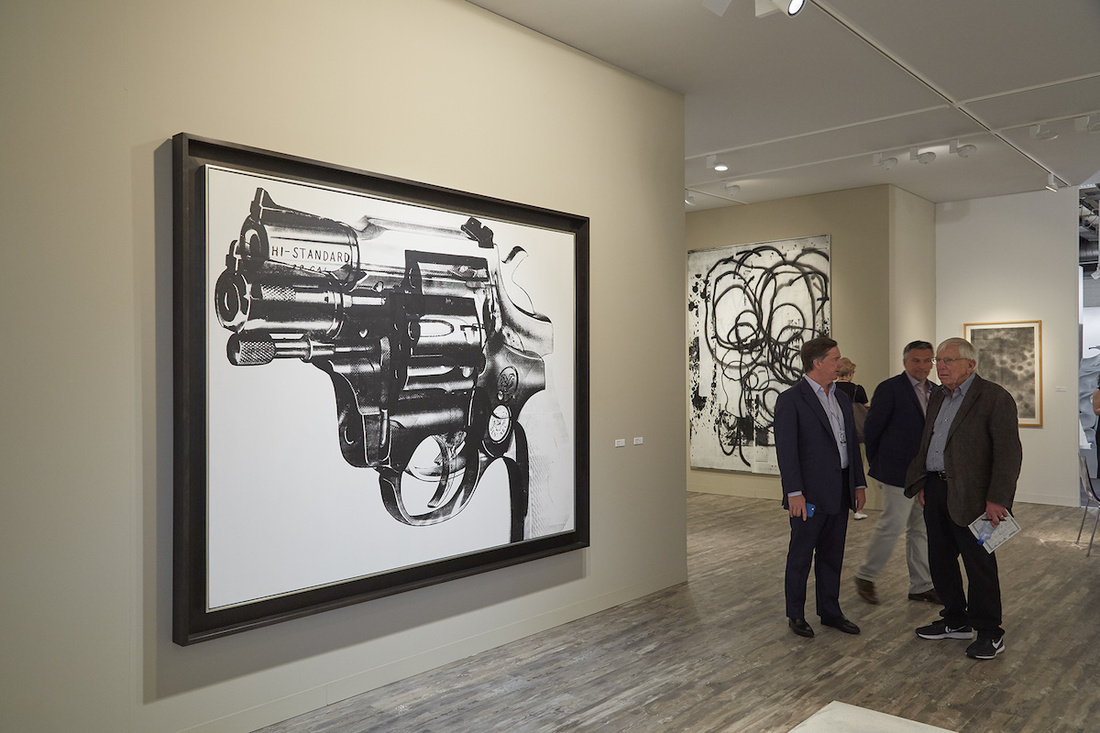 Installation view of Mnuchin Gallery’s booth at Art Basel, 2017. Photo by Benjamin Westoby for Artsy.
Installation view of Mnuchin Gallery’s booth at Art Basel, 2017. Photo by Benjamin Westoby for Artsy.
The mood at the 48th edition of Art Basel in Basel was buoyant, perhaps even jubilant. Was it the function of a European economy that has performed stronger than most had expected? Relief that populism may not be sweeping the Continent after all? A stronger influx of Asian buyers? The long days of nonstop sunshine? The contagion of the miniature dance party in the plaza outside of the conference center in which the art fair is held, courtesy of artist Claudia Comte? This depended on who you asked.
But, no one questioned that the world’s top collectors were ponying up for masterpieces more freely at Art Basel than they have during the past two editions of the fair (and at any other fair over the same time period), bringing some dealers’ sales totals into the tens and twenties of millions of dollars well before the first preview day was over.
Dealers were quick to dispel the notion that this week’s sales were frothy, citing steady economic performance in the world’s major economies, especially those from which many of the biggest collectors hail, such as the U.S., Western Europe, and China. In fact, they almost seemed expected, given what dealers brought to Art Basel: the works in David Zwirner’s booth were worth nearly $100 million, Mnuchin Gallery’s roughly $65 million. One doesn’t bother insuring and shipping over that many treasures without a strong indication that collectors will be in a receptive mood.
To some extent, this is simply Basel being Basel. It is the world’s top art fair, drawing a more prestigious group of collectors and curators than any other fair—and dealers typically save their most coveted works for the occasion. The fair comes amidst a long-awaited period of economic and political calm in this region, after the many surprises of 2016. (Though, of course, the Donald Trump administration in the U.S. continues to generate shock and awe on a near-daily basis.)
The world’s major economies are also, on a long-term basis, potentially at the peak of the current cycle, noted Mark Andersen, the managing director of UBS’s chief investment office. Historically, periods of economic growth tend to last around seven years, followed by a downturn of one to two years. Since the crisis of 2008, the upturn has been largely sustained across the major global economies for the past nine years, an unusually long period.
“People are feeling relatively good at the moment,” Andersen said.
The fair’s mega-dealers were certainly feeling good. Many used phrases like “best ever” and “record” to describe their opening days at Art Basel this year. Zwirner said he thought this year’s fair was on track to be his best ever, and the numbers back him up. By day two, he had pulled in upwards of $40 million in sales. Highlights included Alberto Burri’s Sacco (Sack) (1954) for over $10 million, Sigmar Polke’s Nachtkappe I (Night Cap I) (1986) for €8 million, a selection of paintings and works on paper by Marlene Dumas priced between $150,000 and $3 million, and more works by Wolfgang Tillmans than he could count (upwards of 20, according to a sales report released by the fair), following the artist’s current retrospectives at Tate Modern and the Fondation Beyeler. Even younger artists in his roster got a nod, with a pre-sold untitled work by Whitney Biennial bad boy Jordan Wolfson from 2017 selling for $350,000.
This edition of Basel also had the tailwind of a $1 billion-plus New York auction week behind it, a factor that might have loosened collectors’ grips on works they may have been waiting to put up for consignment after two-plus years of auctioneers and dealers complaining of a lack of supply. Zwirner said the fair was in some ways an opportunity for dealers to prove they can reel in sales results that consignors expect from a heated auction room floor—minus the risk of a public flop.
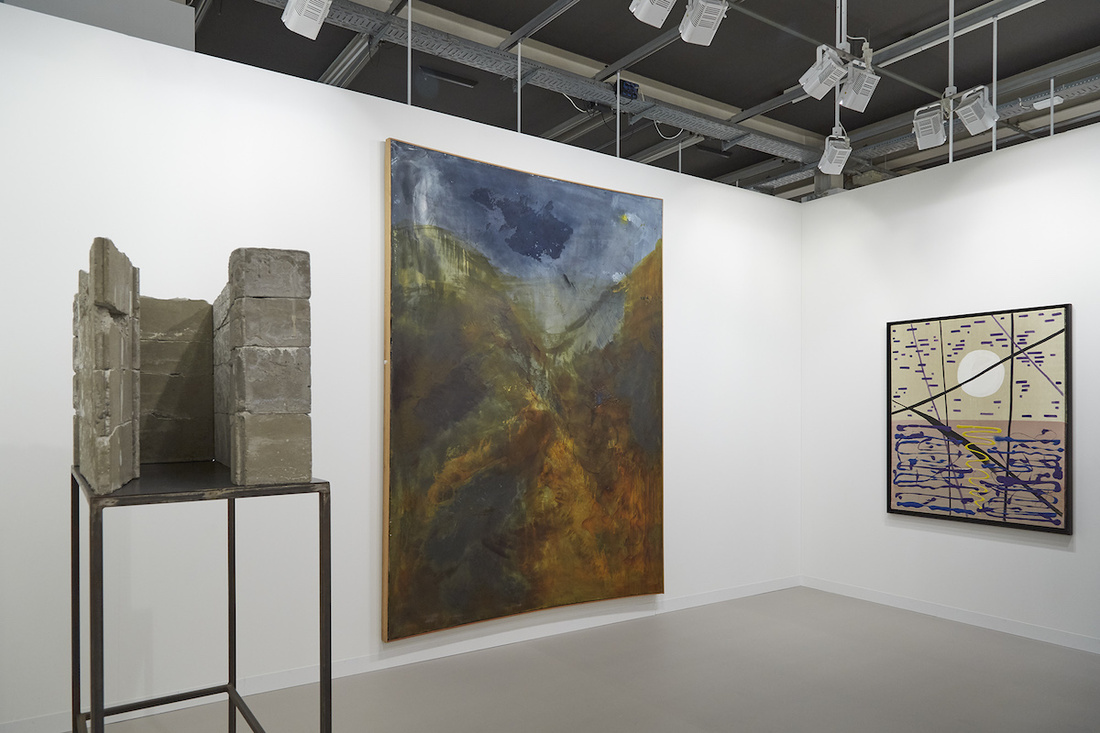 Installation view of David Zwirner’s booth at Art Basel, 2017. Photo by Benjamin Westoby for Artsy.
Installation view of David Zwirner’s booth at Art Basel, 2017. Photo by Benjamin Westoby for Artsy.
“Basel is such a fantastic argument to work with us,” he said. “We're all competing for our clients’ attention and consignments, and I keep telling my clients that putting a piece up prominently and intelligently at Basel is one of the best ways to market a historic work.” He added that clearly a lot of his colleagues had successfully made that argument to their clients as well, noting the number of masterpieces hanging around the fair, especially on the ground floor.
For example, Lévy Gorvy was showing a $35 million painting by Jean-Michel Basquiat. Partner Brett Gorvy said he had agreed to sell for the collector Peter Brant before the $110.5 million Basquiat record reached at Sotheby’s last month—though the gallery did not confirm having found a buyer as of Saturday evening. Other eight-figure results from the early days of the fair included a Philip Guston oil painting Scared Stiff (1970) for around $15 million and a Piero Manzoni Achrome (1958–1959) for over €10 million to a European private collection, both at Hauser & Wirth.
Dozens of works were reported sold in the seven-figure range, a level of activity not reported publicly since 2014. New York’s Mnuchin Gallery made a killing in this range, placing Mark Bradford’s Smear (2015), a mixed media and collage work on canvas for $5 million, Agnes Martin’s Untitled #9, (1988) for $5 million, an untitled Christopher Wool from 2002 for $3.5 million, and Bruce Nauman’s wax sculpture Andrew Head/Julie Head/Rinde Head (1990) for $3.6 million.
High demand continued for works by Sigmar Polke, an appetite that was initially stoked by his major traveling retrospective three years ago. Michael Werner sold one work for €3.5 million to a European collector; Galerie Thaddaeus Ropac sold another (Untitled, 1983-1984) for $4 million.
Depending on who you spoke to, the ultra high-end buying was driven by a handful of price-indiscriminate Asian buyers, or Americans, or Europeans. Zwirner cited less business with Asian collectors than last year, and Thaddaeus Ropac said Asian buyers had missed most of the action at his booth.
“They would have bought, but they were late,” he said with a smile. “Europeans and Americans are still the fastest.”
As with most fairs, much of the action kicks off weeks in advance, when galleries alert their clients to what will be on offer. Ropac said he arrived with many works on triple reserve, and “people were fighting” over the $4 million Polke painting. One collector, in from Tel Aviv, begged him, “Sell me anything!” before he had to get on a flight back to Israel (which Ropac politely declined to do, offering instead to meet in London or Paris for a proper consultation).
“I could feel yesterday this level of adrenaline,” he said, referring to the “First Choice” VVIP preview day on Tuesday. “You can feel it physically, people were just talking to each other, ‘What did you get? What did you get?’”
 Installation view of Galerie Thaddaeus Ropac’s booth at Art Basel, 2017. Photo by Benjamin Westoby for Artsy.
Installation view of Galerie Thaddaeus Ropac’s booth at Art Basel, 2017. Photo by Benjamin Westoby for Artsy.
Even Ropac, buying a $40,000 painting by a young artist (he declined to say who) said he felt compelled to jump the gun. “I could feel, ‘You buy it or you lose it,’” he said.
The fever pitch doesn’t, he said, indicate a bubble. Rather, it’s an indication of the steadily growing collector base. The number of millionaires globally “has increased dramatically since 2000 (rising 155% to 2016), and among them, those with wealth over $50 million have risen the fastest (by over 215%),” according to The Art Market | 2017, with much of that growth happening in emerging markets and particularly Asia.
“It’s just because more and more people are participating” in the art market, Ropac said. “You can see the Chinese are much more secure, they have been in the market long enough that they’re serious now, they’re no longer doing unrealistic offers,” attempts at heavy handed negotiating that several dealers at Art Basel in Hong Kong had mentioned earlier this year. He did sell a Robert Rauschenberg painting to an Asian buyer for $1 million, while other sales included Robert Longo’s Untitled (Eagle) (2017) for $500,000, Georg Baselitz’s Nach unten durch die Tür (2017) and Weiter abwärts (2017) for €500,000 apiece, and Adrian Ghenie’s Untitled (2017) for $250,000.
Asian collectors were more prominent at Hauser & Wirth, which had a “record year” at Basel, said Neil Wenman, a senior director at the gallery.
“We’re selling more works to Asian collectors for sure,” he said. “We’re working very closely with them building their collections, and they’re really understanding the value of work, often by artists that aren’t in the most mainstream collections.”
He agreed the market was on a sustainable footing, or at least that the purchases made at Basel, in the millions and tens of millions, were justified and informed.
“People are being very serious, they’re researching properly...and seeing how these great works, which already have a place in art history, have an inherent value,” he said. His booth included works like the aforementioned Manzoni and Guston, as well as Guston’s Untitled (1969) for $2 million, Richard Serra’s untitled steel triangle wall sculpture from 1975 for $3.5 million, and an Eva Hesse oil painting (No title, 1961) for $2.5 million, which sold to a Chinese museum.
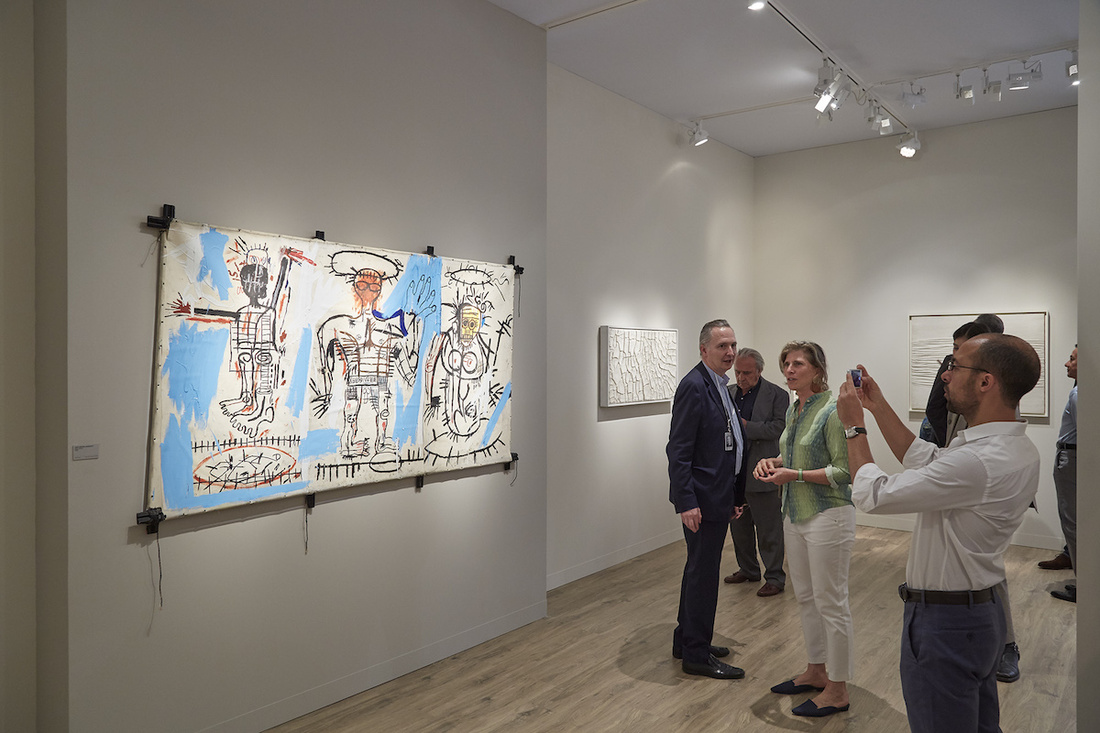 Installation view of work by Jean-Michel Basquiat at Levy Gorvy’s booth at Art Basel, 2017. Photo by Benjamin Westoby for Artsy.
Installation view of work by Jean-Michel Basquiat at Levy Gorvy’s booth at Art Basel, 2017. Photo by Benjamin Westoby for Artsy.
At Art Basel in Hong Kong, dealers had worried that current, strict capital controls imposed on Chinese collectors would hinder buying. And in Basel, there was some chatter about whether Chinese buying was more profligate due to the 8,018 kilometer buffer between Basel and Beijing giving reassurance to Chinese collectors that they could spend at will.
Adam Sheffer, a partner at New York’s Cheim & Read and president of the Art Dealers Association of America, said demographic shifts had also helped spur sales at the top end, as collectors matured and sought more ambitious (and expensive) work. He had sold paintings by Joan Mitchell, Sean Scully, Ron Gorchov, and a sculpture by Lynda Benglis, in a price range between $200,000 and $10 million.
“I think a lot of people that started collecting over the last decade have a lot of stuff now, and they’re starting to determine what’s really meaningful to them,” he said, and are willing to spend to get something they truly love. “Many are starting to rethink their collection...it’s a shift in plate tectonics.”
And he noted that for true art lovers, Basel is still the one required destination annually, with all of its ancillary events and exhibition programming that takes over the city.
“People who make a life in art always look for it as a moment of respite and refuge,” he said, “And Art Basel has represented a real poetic exhale for people this year.”
That’s not to say everything is smooth sailing for everyone. For the last few years, there’s been increasing talk about a bifurcated market. The Art Market | 2017, a report commissioned by Art Basel and UBS, described inequality as a major factor threatening the overall stability of the market, as galleries in the middle- and lower end struggle to survive.
Jane Kallir, who runs the seven-person Galerie St. Etienne in New York, addressed this topic in an essay she issues once a year, describing “A Tale of Two Art Worlds.” In the middle of Art Basel week, a young New York operation, Taymour Grahne Gallery, announced it would be closing after a four-year run. On Friday, older dealers Anthony Reynolds and Janice Guy discussed with Josh Baer their decisions to cease operating within a traditional gallery model with a permanent exhibition space and to close, respectively, due to pressures faced in the current market environment.
For Kallir, catering to a client base of well-off professionals has become increasingly challenging, and demographic shifts such as those described by Sheffer don’t always work in her favor.
“There’s something about the overall cost of living in these cities that have been taken over by the global elite that makes it impossible to cater to a median-income professional class,” said Kallir, whose gallery was founded by her grandfather in 1939. She no longer sells to the doctors, lawyers, and even schoolteachers who once made up her client base, as the cost for essentials such as education and healthcare has left less disposable income while the price of art has climbed out of reach.
“People who would have been my clientele in the ’80s are aging out of the market,” she said. “Some couldn’t afford to buy at today’s prices, but if for whatever reason they made enough money and could continue to collect, they are frozen by sticker shock. They can’t wrap their minds around today’s prices.”
Kallir sold five works on the first day. Although she declined to provide prices, she said a small gallery like hers (with a staff of seven) can survive by selling a modest amount in the $50,000 to $500,000 range, and a few in the $1 million range each year. She said a dealer friend of hers who works with younger artists told her he has to do a “volume business” of five-figure sales to stay in business, and can only survive if he makes a few six-figure sales a year.
But at Art Basel this year, the enthusiasm appeared broad-based, extending to a wide range of galleries, including younger dealers and those new to the fair. And the buying was not just from wealthy collectors; Zwirner’s Polke went to a European museum, and his gallery also sold a Kerry James Marshall painting to an American museum with private patronage, which allows for the institution to “make the decision right here,” rather than wait for deliberations by an acquisition committee, he said.
 Installation view of Goodman Gallery’s booth at Art Basel, 2017. Photo by Benjamin Westoby for Artsy.
Installation view of Goodman Gallery’s booth at Art Basel, 2017. Photo by Benjamin Westoby for Artsy.
Neil Dundas, senior curator at South Africa’s Goodman Gallery, said his booth had seen major interest from institutions, again backed up by wealthy donors.
“It is true many of the big museums are suffering budget cuts, but they’re looking to private people to help fund major acquisitions,” he said, noting sales of their younger artists to European, British and American institutions.
Goodman reported selling works from most of the artists they’d brought, from their oldest artist, 86-year-old photographer David Goldblatt, to their youngest and newest artist, Nolan Oswald Dennis, whose wall mural installation, excerpt: constellations (Black Liberation Zodiac) (2017), was bought by noted collector of contemporary African art and photographer Jean Pigozzi for €20,000. William Kentridge’s video Soft Dictionary (2016) sold for $180,000 and Ghada Amer’s The Grid of 2017 - RFGA (2017), which featured colorful embroidery on canvas, went for $150,000.
Dundas and his colleague Elizabeth Callinicos also noted the appetite for more politically engaged works, such as Gerhard Marx’s RAFT (2017), a collage of cut and reconstituted map fragments referencing refugees and borders, that sold to a private collector.
The enthusiasm extended to younger galleries, especially those in Statements section devoted to solo presentations from emerging artists. Beijing’s Magician Space Gallery had sold nearly all of its sculptures by Chinese artist Wang Shang, arranged like a futuristic sculpture garden in a prime corner booth, said curatorial director Billy Tang.
Kolkata’s Experimenter Gallery, another Statements booth, had also placed two of its charcoal wall paintings by Prabhakar Pachpute, to a French institution and to an Asian institution, both on the first day.
Gallery director Priyanka Raja said presenting a more curated solo show at Statements actually made it easier for a young gallery like hers to stand out, rather than, say, being in the main galleries section with a multi-artist booth as they appear at other fairs (including Art Basel in Hong Kong, for example).
At the Feature section booth of Kalfayan Galleries, a Greek gallery with outposts in Athens and Thessaloniki appearing for the first time at art Basel in Basel, multiple works by the late post-war Greek artist Vlassis Caniaris (currently featured in documenta 14 in Athens and on view at Tate Liverpool) sold to “very important collections.” The booth’s works, priced on the range of €60,000 to €290,000, reference the displacement and mass movement of people during the artist’s time.
“His work dealing with issues of immigration is more timely than ever,” said the gallery manager Yuli Karatsiki, noting that the migration happening now—coming to Europe from places like Turkey or Eastern Europe into Western Europe—mirrors that of the past.
“It opens up so many doors, so many possibilities for us,” Karatsiki said of the Art Basel mothership—even more than in Miami and Hong Kong, where the gallery has participated before. “It’s the name Basel that attracts the best crowd that you would want.”
—Anna Louie Sussman
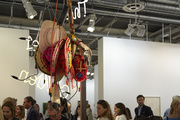

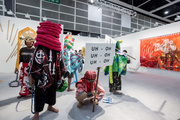


No comments:
Post a Comment